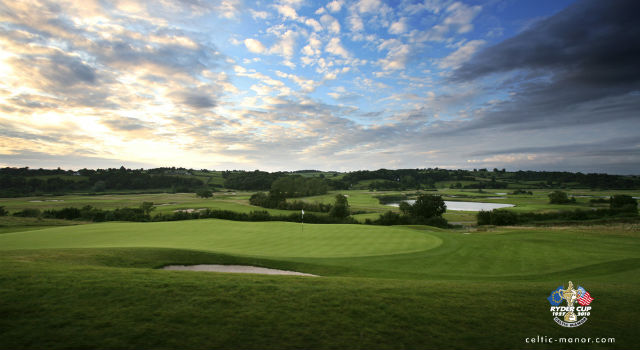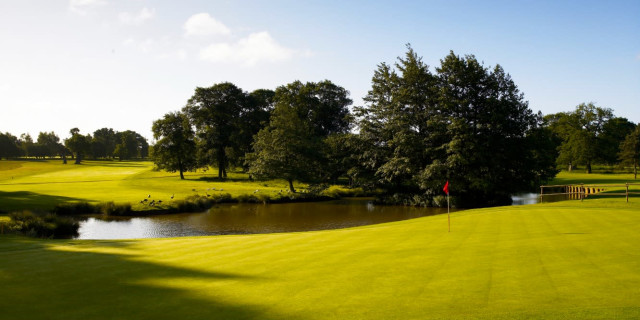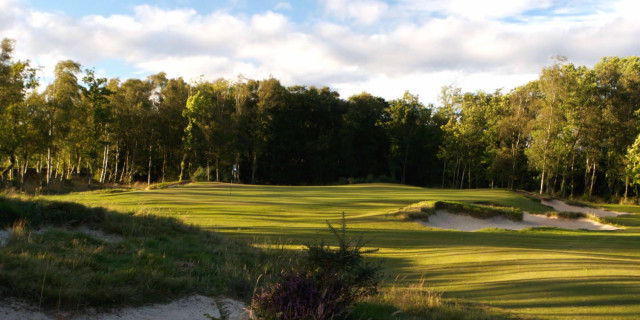Celtic Manor - The 2010 Course
SIR TERRY MATTHEWS was a man with a dream. One of the richest men in Britain, he wanted to build a golf resort in Wales. Not just any old golf resort, and not just any old golf course.
He wanted to build a golf course fit to stage the Ryder Cup. Matthews is not the first (and won't be the last) to have such a plan. The difference between him and most of the others, however, is that he had both the resources and the clout to turn his dreams into reality.
It all started back in 1980 when Celtic Inns Ltd bought a derelict Manor House. The vision for what followed came from Matthews, the company's chairman. He lives in Canada, where he founded two successful telecommunications businesses, Mitel and Newbridge Networks. However, he was born in the Manor House when it was a maternity hospital, and has strong family ties in the area.
From the outset, Matthews realised that the site, with its beautiful surrounding countryside and proximity to the M4, had the potential for development into a thriving business. He also believed that it would help to put Wales on the map, as well as creating jobs for local people.
“I think the resort can act as a magnet to draw new investment into Wales from across the UK and overseas,” he said. “I did my best to put up a building that you can see from the West End of London and I didn’t come far short of it.” While that may be stretching a point, the hotel he built is magnificent and a wonderful focal point for what became Celtic Manor Resort.
It features a soaring atrium, distinctive design and traditional luxury and embodies a feeling of understated glamour that is both opulent, yet comfortably relaxed.
The bedrooms and luxury suites enjoy spectacular views over the Twenty Ten course, which was created for the 2010 Ryder Cup match, when Colin Montgomerie's European team defied dreadful weather to beat the United States. It is set in the Usk Valley, which stretches as far as the eye can see. Award-winning dining and world-class golf and spa facilities provide the finishing touch for a stay in complete luxury at one of Europe’s finest resorts.
The Resort Hotel is home to flagship dining at the Terry M, The Olive Tree and Merlins Bar, along with the the magnificent Forum Health Club and Spa, Forum Café and the Celtic Mall.
Complimentary guest shuttles are available on request to all areas of the resort, providing easy access to the golf courses, clubhouses and restaurants. Guests also enjoy free phone calls to UK landlines, free Wi-Fi internet access and complimentary use of the Forum Health Club leisure facilities.
So just how good is the Twenty Ten course? It certainly wasn't seen at its best during the Ryder Cup but it was testimony to the quality of the layout that it managed to withstand such torrential rain and still produce conditions that were good enough to host some of the world's finest golfers. Nobody had ever produced a purpose-built course for the Ryder Cup, and there were those who felt Matthews had lost his mind when he announced plans to do just that.
Read our Celtic Manor Resort overview >>>
But, as they say, the end justifies the means. Did Matthews and his team pull it off? You bet they did.
It measures a formidable 7,493 yards off the back tees and has a par of 71. With water hazards on half of its holes, the course has six signature holes and presents many more memorable tests and risk-and-reward dilemmas. One of the features of the course is its sheer variety with many of the holes on the front nine having a links-like feel with long rough and greenside swales, before the middle section reveals the full extent of the lake-lined challenge.
A tough finishing stretch culminates in a real sting in the tail at the 18th.
Like the course, the Twenty Ten Clubhouse was purpose-built for the 2010 Ryder Cup and is a fitting venue to host the world’s top golfers. As well as state of the art facilities, the clubhouse is situated to take full advantage of its prominent position overlooking the 18th green - a signature hole of The Twenty Ten course.
Before going out to play, members and visitors are treated to a spectacular panoramic view of the course and of the final hole from a private balcony which wraps around the building. As luxurious as it is dramatic, this is surely a place to make an impression.
The Twenty Ten course:
1st, par 4, 465 yards
The first is a risk and reward hole where an accurate drive down the left hand side will leave an easier approach. However, bunkers on the dogleg make this shot more challenging with the right hand side the safer line, despite leaving a more difficult angle into the green. As with many greens on the Twenty Ten Course, the first has steep swales surrounding the green making it hard to hold your ball on the putting surface with an inaccurate approach shot.
2nd, par 5, 610 yards
At 610 yards, the second is the longest of four par fives. The River Usk runs parallel to a narrow fairway that features deep bunkers on both sides. A second line of traps provides another threat for shorter hitters, with most looking to find the green in three shots following a lay-up. A sloping green again features with anything short or left leaving a test for the short game.
Hole 3 Par 3 – 189 yards
Precision is key on the third with scoring dictated by pin position. Following a carry over water of 160 yards, a large bunker guards the front of the green.
Hole 4 Par 4 – 461 yards
Like many of the new holes on the Twenty Ten, the fourth was created with a well controlled second shot needed to score well. While the tee shot is simple enough, bunkers and the prevailing wind make a tough shot to a sloping green even more difficult.
Hole 5 Par 4 – 433 yards
Hitting the fairway is crucial to find the green in regulation. A stream beneath the green will punish a poor approach shot and anything long will leave a difficult up and down.
Hole 6 Par 4 – 422 yards
The sixth brings water into play if you leak your drive to the right. Two raised bunkers protect a green that requires an accurate second shot to give a birdie chance. Misjudge your approach, and the ball will find the water.
Hole 7 Par 3 – 213 yards
The second of the par threes features a large bunker on the left running the entire length of the green. A deep bunker on the right further guards this tough hole.
Hole 8 Par 4 – 439 yards
Raised fairway bunkers left and right will intimidate many and may even cause problems for the second shot - especially out of the sand - as the green is hidden. Greenside bunkers front and rear will punish a wayward approach.
Hole 9 Par 5 – 580 yards
Reachable in two for big hitters and a good chance for a birdie. Two bunkers to the right of the fairway must be avoided. There is a huge bunker front right of the green and a deep pot bunker on the left.
Hole 10 Par 3 – 210 yards
Pot bunkers surround the green, which slopes back to front and left to right.
Hole 11 Par 5 – 562 yards
Despite a twisting fairway and a pot bunker on the right of the fairway, the 11th offers another good birdie opportunity. Avoid the water on the left and the green can be hit in two, but two small pot bunkers at the front will swallow a wayward approach.
Hole 12 Par 4 – 458 yards
Two shots over water are needed to reach the 12th green with a good second shot needed to find the green. A small green is guarded by several bunkers.
Hole 13 Par 3 – 189 yards
A tough hole that requires a 150-yard carry over water. Two deep bunkers sit at the back of the green - find either and you face a difficult up-and-down back towards the water across a fast putting surface.
Hole 14 Par 4 – 485 yards
The 14th is a monster that needs two excellent shots. While longer hitters will try to carry the water, the more conservative line is down an unguarded fairway. But this leaves a more awkward angle into a narrow green.
Hole 15 Par 4 – 377 yards
A well-struck tee shot carrying 270 yards will reach this par four from the tee. Two deep bunkers at the front of the green lie in wait, while two bunkers on the dogleg look to capture the safer tee shot.
Hole 16 Par 4 – 499 yards
A narrow fairway with bunkers on both sides. Long hitters will attempt to carry the bunker on the left, while anything heading right will find sand or roll down the embankment. Having carried the bunker, an intimidating approach awaits into a green that slopes left to right.
Hole 17 Par 3 – 211 yards
Playing along the line of the hillside, this par three requires an accurate shot to a narrow green that slopes severely from left to right and is protected by deep bunkers.
Hole 18 Par 5 –575 yards
The finishing hole calls for a draw from the tee to leave the best chance of making the green in two. Finding the two bunkers on the left of the fairway will force a lay-up, while two large bunkers protect the front of the green.
For more information on play & stay breaks at Celtic Manor please vsit Golfbreaks.com - Click Here
Related Content:
What do you think? post your thoughts and feedback on the Golfshake Forum: https://forum.golfshake.com/





















